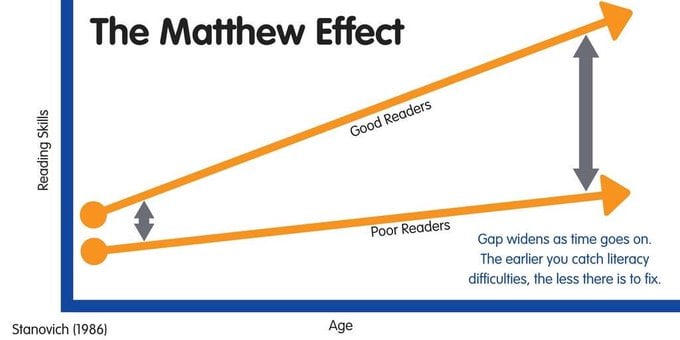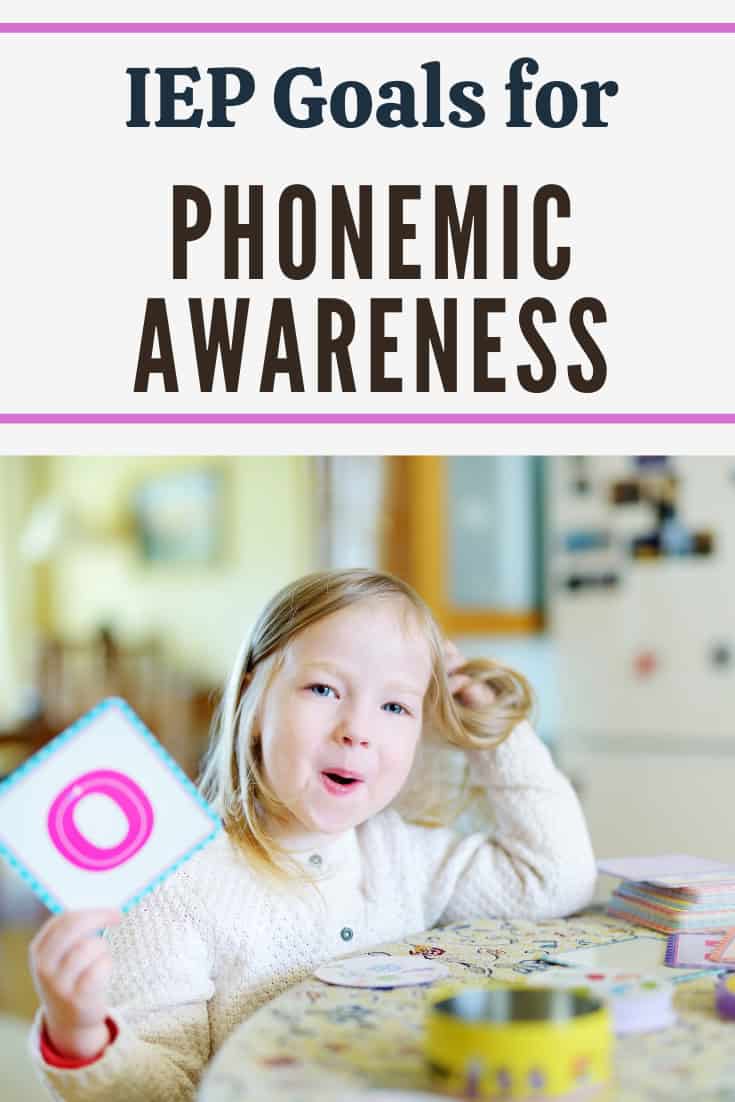16 IEP Goals for Phonemic Awareness
The other day, my 13-year-old sports fan and I had a short but confusing discussion. I knew he was looking at a sports-something on Instagram, and it was the first day of NBA free agency. “Mom, what does resigned mean?”
I explained to him that it means to quit, as in quitting a job. “No,” he went on. “Re-signed.” he said, putting emphasis on the ‘re.’

Again, using my clues and cues and knowing that he was following NBA players, I told him that meant that a player must have re signed with his team. Signed again.
“No. He can’t play with them anymore.” At this point I asked to look at his phone.
Rescind. That’s the word he was looking at.
“Ah! Rescind!” Now that I could see the word, I could explain it to him.
Also read: Phonological Awareness vs Phonemic Awareness: What’s the Difference and What’s the Same?
Phonemic Awareness
He was decoding and trying to comprehend.
He was getting there, using his existing knowledge base and the clues around him. He knew what this player had done (domestic violence) and knew that my answers of “quitting” and “signing again” were incorrect.
Phonological awareness is an essential skill that kids need order to be successful with reading. Reading is an inherently oral activity. It’s almost impossible for children to read fluently without the ability to hear words and decode their meaning.
Definition of Phonemic Awareness
Phonemic awareness is the ability to hear and segment sounds into their component parts, phonemes. This helps kids understand how combined letters create words and how individual letters (and sometimes groups of letters) can change the word they’re creating.
Phonemic awareness is critical because it helps kids break down words they read and comprehend them better.
It also plays a role in reading comprehension and fluency. Besides, having good phonemic awareness makes reading easier for elementary school kids because it provides a foundation for learning to read decently.
Specifically, phonemic awareness helps children identify individual speech sounds (phonemes), analyze the letter combinations that make up those sounds, and use this knowledge to break down new words they encounter into their component parts.

Phonemic awareness vs phonological awareness are often used interchangeably but they are not the same thing. I have a separate post on the differences between phonological awareness vs phonemic awareness.
Phonemic awareness is the ability to discern the separate sounds within a word. Such as, breaking down the word “word” into its separate sounds–the w, the or/er sound and the d sound.
Phonological awareness takes it a step further. The child can decode the word “word” but can also count the syllables, coming up with a list of rhyming words, a list of other words that begin with w and so on.
Phonemic awareness is a pre reading skill.
Some kids can practice reading aloud and sounding out words, also called decoding, with little intervention. Some students, if not given any explicit instruction, will naturally learn phonological awareness skills on their own through listening and speaking activities.
But, not every child can learn these skills inherently–they need direct explicit instruction.
And, this is where many struggling readers get “stuck.”
Priddy Books are very popular, and phonemic awareness skills is a big reason why.

Phonemes
A phoneme is a small part of a word that has an individual sound in the English language. For example, the word “book” begins with a b-, which is pronounced as [b].
Phonemes also include:
- Consonants
- Diphthongs
- Triphthongs
- Final Consonants
- Final Vowels
If a child has a learning disability of some kind, you can see how this will affect phonemic awareness. APD or Auditory Processing Disorder may mean that it sounds different to them than it does others. Or, that they process the information more slowly with autism, ADHD or dyslexia.
When you don’t struggle with information processing, we tend to take it for granted.
If your child is struggling to learn to read, don’t delay. Go with your gut and ask for IEP evaluations. If interventions are not given to the child, the gap will only widen with something called the Matthew Effect in Reading.

Developing Phonological Awareness
According to the National Institute of Child Health and Human Development (NICHD), there are four important aspects of phonological awareness that must be trained in order to develop fully.
Letter-Sound Knowledge
Letter-sound knowledge is the ability to know what letter sounds a word starts with and ends with. This knowledge is foundational in reading and learning more complex words. For example, if your child knows that “di” begins with the letter “d,” they will be able to read the word “die,” which is a much easier task than if they don’t know where the “d” sound begins.
Word Recognition
The ability to recognize a spoken word is the first step to learning how to read. Once your child has mastered recognizing words, they will be able to learn about word structure and better understand what’s going on when they read.
Word Segmentation
A big part of phonological awareness is word segmentation. This is the ability to identify where one word ends and another begins.
For example, you may see all of these words as separate words, but they are actually just one word with three different sounds. Word segmentation includes being able to recognize which sounds belong to a word and understanding that some words can be made up of two sounds.
Word Fluency
NICHD also says that word fluency is a skill that must be trained for children to be able to read at a higher level. This includes the ability to read aloud, sounding out words with little or no hesitation, and reading quickly.
The goal of teaching phonological awareness skills is to help kids develop basic reading skills, but these skills are also important for their future success in school and beyond.
Phonemic Awareness Evaluations
Phonemic awareness is commonly assessed via a phonemic awareness assessment. This assessment is usually done by an occupational therapist, speech-language pathologist, or teacher. If you disagree with the results, you should learn and pursue asking for an IEE.
They may also use the results of their assessment to recommend a plan for your child.
Make sure the assessment is normed or calibrated for your child. For example, if your child is 3 years old, he or she would need an assessment that was for children aged 3-6 years old to get the most accurate results.
You can also ask your occupational therapist or speech-language pathologist which assessments they prefer to use when working with children who share your child’s concerns.
Phonemic Awareness IEP Goals
I have reading IEP goals, including Phonemic Awareness and Phonological Awareness, in other articles.
Here are six IEP (Individualized Education Program) goals for phonemic awareness:
- Goal: The student will demonstrate the ability to identify and produce rhyming words. Objective: Given a set of words or pictures, the student will correctly identify and generate at least five rhyming words for each given word, with 80% accuracy.
- Goal: The student will improve phoneme segmentation skills. Objective: Given a spoken word, the student will accurately identify and verbally separate the individual sounds or phonemes in the word, with 90% accuracy.
- Goal: The student will develop phoneme blending skills. Objective: Given a set of individual phonemes or spoken sounds, the student will accurately blend them together to form a complete word, with 80% accuracy.
- Goal: The student will enhance phoneme manipulation abilities. Objective: Given a word, the student will change, add, or remove individual phonemes to create new words, demonstrating understanding of phoneme manipulation, with 75% accuracy.
- Goal: The student will improve phonemic awareness of initial sounds. Objective: Given a set of pictures or objects, the student will correctly identify and verbally state the initial sound of each item presented, with 90% accuracy.
- Goal: The student will develop phoneme substitution skills. Objective: Given a word, the student will replace one or more phonemes with different sounds to create a new word, demonstrating understanding of phoneme substitution, with 70% accuracy.
- By the end of the school year, when given a set of three spoken words, the student will be able to identify and orally produce the beginning, middle, and ending sounds in each word with 80% accuracy in four out of five consecutive sessions.
- By the end of the first semester, when presented with a list of 20 CVC (consonant-vowel-consonant) words, the student will orally segment each word into individual phonemes with 90% accuracy.
- Over the course of the school year, the student will demonstrate the ability to blend individual phonemes to correctly decode multisyllabic words with 70% accuracy in reading passages.
- By the end of each quarter, given a word with a specific phoneme omitted, the student will orally produce the word with the correct phoneme substitution in four out of five opportunities.
- By the end of the semester, when presented with a list of 20 words, the student will be able to identify and distinguish between rhyming and non-rhyming pairs with 85% accuracy.
- By the end of the school year, the student will orally generate a list of words that begin with the same initial sound as a given target word with 80% accuracy across ten trials.
- By the end of each marking period, when presented with a spoken word, the student will orally segment the word into its constituent phonemes with 90% accuracy in five out of six opportunities.
- Over the course of the school year, the student will develop the ability to orally blend phonemes to form words with 80% accuracy in reading tasks.
- By the end of each quarter, when presented with a set of words, the student will orally segment each word into its individual phonemes and record them using letter tiles with 90% accuracy in three out of four opportunities.
- By the end of the semester, when given a list of words containing various phonemes, the student will orally identify and categorize the initial, medial, and final phonemes in each word with 75% accuracy in four out of five consecutive sessions.
These goals and objectives should be tailored to the individual student’s needs and abilities.
Remember, phonemic awareness is the pre skill to phonological awareness. Don’t let your IEP team put the proverbial cart before the horse–they have to learn one before they can move on to the other.
Reading and Writing IEP Goals
- 28 Spelling IEP Goals for All Ages, Abilities and Common Core Standards
- How to Write a Meaningful IEP for Dyslexia (includes IEP Goals for Dyslexia)
- 36 Decoding IEP Goals (Examples and Samples)
- 25 Measurable Basic Reading Skills IEP Goals
- 14 Letter Recognition IEP Goals (including OT)
- 16 IEP Goals for Phonemic Awareness
- 28 Sample Vocabulary IEP Goals
- 60 Kindergarten IEP Goals including Reading, Writing and Math.
- 53 Measurable IEP Goals for Writing and Written Expression (and Objectives)
- 46 Reading Comprehension IEP Goals, including Fluency
- Free IEP Goal Bank with 1000+ Measurable IEP Goals and Objectives separated by Domain
Speech and Communication IEP Goals
- 20 Measurable Pragmatic Language IEP Goals (samples and examples)
- 20 Listening Comprehension IEP Goals (and Examples)
- 16 IEP Goals for Phonemic Awareness
- 77 Functional Communication Goals for an IEP
- 15 IEP Goals for Assistive Technology and AAC


